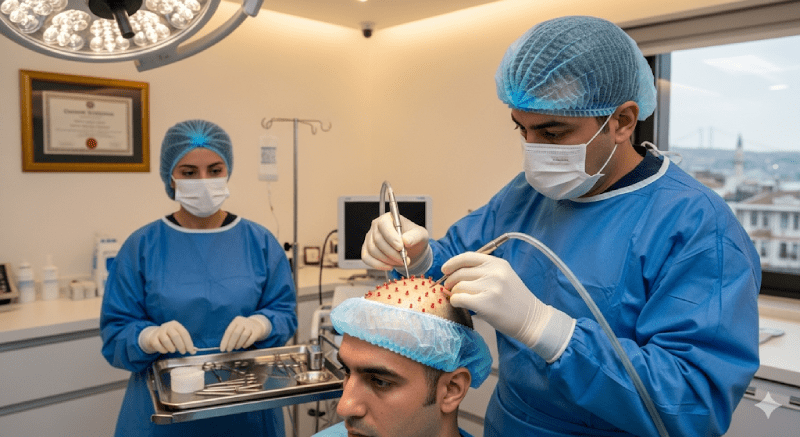What is the average cost of DHI hair transplant in Turkey?
The average cost of DHI hair transplant surgery in Turkey is slightly higher than the FUE technique. Prices can range from 2,500 to 5,000 USD, depending on the clinic’s location, the surgeon’s experience, and the services included in the package.
This price is valid for “all-inclusive” packages, which generally cover additional services such as accommodation and transfers, in addition to the operation itself. DHI being a more specialized technique and requiring more manual dexterity is the main factor increasing its cost. It is important to learn the package contents in detail when getting a price quote.
What is included in a DHI hair transplant package?
DHI hair transplant packages in Turkey are generally comprehensive and designed to be “all-inclusive.” These packages cover the surgery itself (including a predetermined number of grafts), all necessary pre- and post-operative medical check-ups, necessary medications, and hair care products, as well as post-operative equipment such as bandages, splints, and pillows. Additionally, airport and hotel transfers, a 2-3 night stay in a luxury hotel, and in some cases, translation services are also included in the package. This holistic approach ensures foreign patients have a more comfortable experience.
How does the cost of DHI compare to FUE?
DHI hair transplant is generally more expensive than the FUE technique. The main reason for this is that the DHI technique requires more time, precision, and specialized equipment. In DHI, a special tool called the Choi Pen is used, which allows for the direct implantation of hair follicles immediately after they are collected without opening channels. In FUE, the channels are manually opened. This direct implantation method offered by DHI shortens the time the grafts remain outside the body, increasing the success rate, which accounts for the price difference.
Why is DHI more expensive than FUE?
There are several main reasons why DHI is more expensive than FUE. First, the cost of the special device called the Choi Pen used in the DHI technique is higher. Second, this technique can be a longer operation as it requires more attention and skill. Hair follicles are implanted one by one, at the correct angle and depth, which makes the operation more precise. Finally, more surgical team members (usually 2-3 people) are involved during the operation. The combination of these factors increases the cost of DHI compared to FUE.
Are there different pricing tiers for DHI?
Yes, there are different pricing tiers for DHI hair transplants. Prices are generally determined by the prestige of the hospital where the surgery will be performed, the surgeon’s experience, the additional services included in the package, and the number of grafts. For example, an operation performed by a well-known surgeon in a luxury hospital will be more expensive than one performed by a less-known surgeon in a more standard clinic. Additionally, there are options that include extra services, such as VIP packages.
How do 2025 prices compare to previous years?
In 2025, DHI hair transplant prices have increased slightly compared to previous years due to general inflation and rising material costs. However, thanks to the favorable exchange rate in Turkey and the competitive pricing strategies of the clinics, prices remain at a very affordable level compared to European and other Western countries. Clinics aim to keep price increases minimal to maintain Turkey’s leading position in health tourism.
Are DHI packages all-inclusive?
Most DHI packages in Turkey are offered as “all-inclusive,” which prevents patients from facing surprise costs. A typical package includes the surgery, anesthesia, medications, and products like shampoos and lotions. Additionally, airport transfers, hotel accommodation (usually for 2-3 nights), and post-operative check-ups are also included in the package. However, it is always best to confirm the package contents in detail, for example, by asking how many nights of accommodation and which transfers are included.

How is the cost per graft calculated for DHI?
The cost per graft in DHI hair transplant is generally calculated by dividing the package price by the total number of grafts. However, many clinics do not price based on the number of grafts but rather through packages such as “unlimited grafts” or “maximum grafts.” These packages aim to implant the maximum number of grafts that can be harvested from the patient’s donor area. Therefore, it is a more accurate approach to evaluate based on the total package price rather than getting a net price per graft.
Is a DHI transplant possible on a low budget?
Although the DHI technique is more expensive than other methods, it is possible to find low-budget options in Turkey. Some clinics may offer more affordable packages or organize seasonal campaigns. However, it is important to be cautious of very low-priced offers, as this may mean a compromise on quality or hygiene standards. It is critical to do detailed research and examine patient reviews to find a reliable and affordable clinic.
What factors affect the final cost of a DHI transplant?
Many factors affect the final cost of a DHI transplant. The most important of these include the number of grafts for the operation, the location and reputation of the clinic, the surgeon’s experience, the technological equipment used, and the additional services included in the package (accommodation, transfer, special care products). Especially VIP packages or requests for additional treatments can increase the cost. Therefore, it is important to clarify all details when getting a price quote.
What is the difference between DHI and Sapphire FUE?
DHI and Sapphire FUE are popular techniques used in hair transplantation. The biggest difference arises in the channel opening stage. In Sapphire FUE, after the hair follicles are collected, channels are opened with special blades with sapphire tips. In DHI, this stage is skipped, and the hair follicles are directly implanted with a special tool called the Choi Pen. The DHI technique can result in less bleeding and a faster recovery process because channels are not opened, while Sapphire FUE also allows for a more natural-looking result.
What are the advantages of DHI hair transplant?
DHI hair transplant has many significant advantages. First, because the hair follicles are implanted immediately after they are collected, the time the follicles remain outside the body is minimized, which increases their viability and results in a higher success rate. Second, since channels are not opened, it offers less bleeding and a faster recovery process. Finally, because the hair follicles are implanted one by one at the correct angle and depth, a more natural and dense appearance is achieved.
What are the disadvantages of DHI hair transplant?
The DHI technique also has some disadvantages. The most important disadvantage is that it is a longer operation compared to other techniques. Additionally, because the DHI technique requires more skill and expertise, not every surgeon can perform this method. This also increases the cost of the operation. Finally, the DHI technique may not be suitable for every hair type or degree of baldness, so it is important to consult with your surgeon to determine the most suitable technique for you.
Is it possible to get a DHI hair transplant without shaving the head?
Yes, the DHI technique is an ideal method for “unshaven hair transplant,” especially for women and individuals who do not want to cut all their hair. However, the feasibility of this method depends on the condition of the donor area (usually the back of the head) and the number of grafts to be implanted. If a large number of grafts are to be implanted, a small area of the donor region may need to be shaved for clearer visibility. Your surgeon will make the most accurate decision on this matter.
How many grafts do I need for a DHI transplant?
The number of grafts needed varies depending on the degree of hair loss, hair structure, the density of the donor area, and the desired result. The DHI technique is generally preferred for operations in the range of 1,500-3,500 grafts, as the operation time can be very long for a higher number of grafts. To determine the exact number of grafts, you need to consult a specialist and have your hair analysis performed.
How long does the DHI hair transplant procedure take?
The DHI hair transplant procedure can take longer than the FUE technique. The operation generally lasts between 6 and 9 hours, depending on the number of grafts to be implanted. Each hair follicle is collected one by one and implanted at the same time, which is a time-consuming process. Therefore, you should set aside your entire operation day for this procedure and be patient.
What is the post-DHI recovery process like?
The post-DHI recovery process is faster and more comfortable compared to FUE. Since there is no channel opening, there is less bleeding and swelling. The donor area is covered with a bandage within the first 24 hours, and the first wash is usually done at the clinic 48 hours after the operation. Mild pain, redness, and scabbing are normal in the first few days. These symptoms significantly decrease within a week.
When can I return to work after DHI?
The time to return to work after a DHI hair transplant varies depending on the nature of your job. If you have a desk job and it does not require physical activity, you can return to work 2-5 days after the operation. However, if you work in a physically demanding job or in an environment where there is a risk of head trauma, this period can extend up to 1-2 weeks.
Is DHI hair transplant safe in Turkey?
Yes, DHI hair transplant in Turkey is a safe operation with high standards. Turkey’s health tourism sector has gained a lot of experience in this field. Many clinics have international accreditations, and operations are performed in sterile, modern hospital environments. However, as always, it is of vital importance to choose a well-researched and highly-rated clinic and surgeon for the operation.
What are the risks of DHI hair transplant?
The risks of DHI hair transplant are similar to other hair transplant methods such as FUE. The most common risks include infection, bleeding, scarring in the donor area, swelling (edema), and temporary numbness. These risks are minimized by the surgeon’s experience, the clinic’s hygiene standards, and the patient’s strict adherence to post-operative instructions.
How can I find a good DHI clinic in Turkey?
You need to do comprehensive research to find a good DHI clinic in Turkey. First, examine the clinic’s website and social media accounts. Carefully review patient reviews and before/after photos. Inquire about the surgeon’s experience and expertise in this field. If possible, book an online consultation to test the clinic’s approach and transparency.
What should I ask during the pre-operative consultation for DHI?
During the pre-operative consultation, there are important questions you should ask your surgeon. These include: “How many years have you been performing hair transplants?”, “What is your expertise in the DHI technique?”, “How many grafts do you plan to implant in this operation?”, “What services are included in the package?”, “How does the post-operative follow-up process work?”, and “What are the possible risks?”. These questions increase your confidence in the surgeon.
Are follow-up services included in DHI packages?
Yes, reputable DHI clinics usually include comprehensive follow-up services in their packages. These services cover wound dressing and the first wash appointments in the days following the surgery. Later, when the patient returns to their country, regular follow-up sessions are organized, usually via online video calls or by sending photos via WhatsApp. This ensures that the patient’s recovery process is closely monitored.

How long do I need to stay in Turkey for the DHI procedure?
The time you need to stay in Turkey for the DHI hair transplant procedure is generally 3 days. On the first day, the surgery is performed; on the second day, the first check-up and bandage removal are done; and on the third day, the first hair wash and final check-up are performed. This 3-day period covers all stages of the operation and the doctor’s initial check-ups.
Is DHI suitable for everyone?
While the DHI technique is suitable for many patients, it may not be an ideal method for everyone. It is generally more suitable for individuals who need dense implantation and have a hair loss level below 3 or 4. In cases where the patient is completely bald or a very large area needs to be implanted, FUE or other techniques may be more suitable. Your surgeon will make the most accurate decision.
What is the minimum number of grafts for a DHI transplant?
Although there is no definite minimum number of grafts for a DHI hair transplant, this technique is generally preferred for densifying smaller areas or restoring the front part of the hairline. It usually provides effective results in the range of 1,000 to 3,500 grafts. It can also be applied in cases where fewer grafts are needed.
Do DHI packages include accommodation and transfers?
Yes, many DHI clinics in Turkey include accommodation and transfer services in their packages for international patients. This covers transfers from the airport to the hotel and from the hotel to the clinic. Usually, a 2-3 night stay in a luxury hotel is also included in the price. These services make the patient’s travel and treatment process more comfortable.
What are the results of a DHI hair transplant like?
When performed correctly, DHI hair transplant yields highly natural and successful results. Because the hair follicles are implanted one by one at the correct angle, the natural hair direction is preserved, and the hair gains a natural appearance as it grows. The first results begin to be visible after a few months, and the full results become clear within 9-12 months.
Is a DHI transplant painful?
DHI hair transplant is performed under local anesthesia, so no pain or discomfort is felt during the operation. The anesthesia applied before the surgery ensures that both the donor and the implantation areas are completely numb. There may be a slight soreness or discomfort after the surgery, but this can be easily controlled with prescribed pain relievers.
How is DHI different from other techniques?
DHI fundamentally differs from the FUE technique in two ways. First, in DHI, hair follicles are directly implanted with a special implantation pen (Choi Pen) immediately after they are collected. Second, while in FUE, the channel opening and graft implantation stages are performed separately, in DHI, these two stages are combined into a single step. This makes DHI a more precise and direct method.
What is the role of the Choi Pen in DHI?
The Choi Pen is the most important tool of the DHI hair transplant technique. This special pen holds the hair follicle and performs both the channel opening and graft implantation in a single step. The Choi Pen allows the surgeon to place the hair follicle at the correct angle, depth, and direction. This preserves the natural direction of the hair and results in a more natural look.
What is the long-term success rate of DHI?
The long-term success rate of the DHI technique is quite high. Due to the short time the grafts are outside the body, more than 95% of the implanted hair follicles can remain viable. The success of the surgery depends on the surgeon’s experience, the patient’s genetic makeup, and post-operative care.
Can DHI be combined with other hair treatments?
Yes, DHI hair transplant can be combined with treatments such as PRP (Platelet-Rich Plasma) or other hair mesotherapy. PRP treatment can accelerate the post-operative recovery process and help the hair follicles grow stronger. Such additional treatments are recommended to increase the final success of the surgery.
When can I see the results?
The results of a DHI hair transplant appear gradually. In the first month, the implanted hairs usually fall out (shock loss). New hair starts to grow after 3-4 months, and a noticeable thickening is seen after 6 months. The full results of the surgery become clear within 9 to 12 months.
How much is a DHI hair transplant in Istanbul?
Istanbul is the center of hair transplantation in Turkey, and DHI hair transplant prices here are highly competitive. Prices can vary depending on the clinic’s location (for example, in central districts like Şişli or Beşiktaş), the technologies used, and the services included in the package. On average, DHI prices in Istanbul can range from 2,500 to 5,000 USD.



